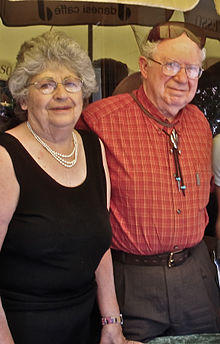Gerald Estrin
Gerald Estrin (born September 9, 1921 in New York City , † March 29, 2012 in Los Angeles ) was an American computer scientist.
Estrin studied electrical engineering at the University of Wisconsin with a bachelor's degree in 1948, a master's degree in 1949 and a doctorate in 1951. From 1950 to 1956, he was an engineer in the group of John von Neumann , who used a number of early computers based on von Neumann's plans at the institute for Advanced Study ( IAS computer ). At the invitation of the Weizmann Institute , he built a similar computer in Israel as head of the WEIZAC project (1954/55). He became professor of computer science at the University of California, Los Angeles (UCLA), where he headed the computer science faculty from 1979 to 1982 and 1985 to 1988. In 1991 he retired.
With work in the late 1950s and early 1960s, he is considered a pioneer of reconfigurable computing (reconfigurable computing with special hardware components, for example for image recognition, which were each reprogrammed, but with their special structure were much faster than sequential computers) in the Fixed plus Variable Structure Computer at UCLA. The idea was ahead of its time and was only pursued later with the advent of FPGAs .
In 1996 he received the Computer Pioneer Award . He is a Fellow of the IEEE , was a Guggenheim Fellow and is on the Board of Directors of the Weizmann Institute .
His daughter Deborah Estrin is a computer science professor. His daughter Judith Estrin is also a computer scientist and businesswoman and manager of various software companies. His wife Thelma Estrin (* 1924) is also a computer science professor at UCLA and dealt with biomedical research and expert systems.
Web links
| personal data | |
|---|---|
| SURNAME | Estrin, Gerald |
| BRIEF DESCRIPTION | American computer scientist |
| DATE OF BIRTH | September 9, 1921 |
| PLACE OF BIRTH | New York City |
| DATE OF DEATH | March 29, 2012 |
| Place of death | los Angeles |
